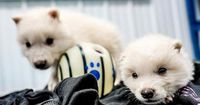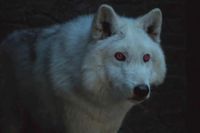In a groundbreaking development that sounds like it belongs in a sci-fi movie, three dire wolves have been brought back to life, thanks to the innovative work of Colossal Biosciences, a biotechnology company based in the United States. This feat marks the first significant step in what the company describes as the world’s first de-extinction project, reviving a species that has been extinct for about 12,500 years.
The dire wolves, named Romulus, Remus, and Khaleesi, were created using advanced genetic manipulation techniques. Colossal Biosciences utilized DNA from a 13,000-year-old tooth and a 72,000-year-old skull to reconstruct the genome of these ancient predators. The company claims to have identified twenty key differences in fourteen genes that contribute to the dire wolf's larger size, distinctive white fur, and larger teeth compared to modern wolves.
Ben Lamm, CEO of Colossal, expressed his pride in the team’s achievement, stating, “I am incredibly proud of the team. This monumental milestone is the first of many upcoming examples that demonstrate our comprehensive de-extinction technology works.” He noted that the process involved using the reconstructed DNA to create embryos that were implanted in the wombs of domestic dogs, resulting in the birth of the pups via cesarean section.
Romulus and Remus were born on October 1, 2024, while Khaleesi followed three months later. The names of the wolves draw inspiration from both mythology and popular culture, particularly from the hit series “Game of Thrones,” where dire wolves are a prominent feature. This clever marketing strategy has garnered significant media attention, including a cover story in Time magazine.
However, the effort has not been without controversy. Critics argue that the dire wolves are essentially just genetically modified versions of the gray wolf (Canis lupus), and the remaining dire wolf DNA is insufficient to create a true genetic clone. Some researchers have raised concerns about the authenticity of the project, suggesting that the use of modern wolf DNA compromises the integrity of the dire wolf’s genetic lineage.
Colossal Biosciences has also faced skepticism regarding the broader implications of their work. Critics point out that while the company is focused on de-extinction, many current species are facing extinction due to habitat loss and climate change. There are calls for more resources to be directed toward preserving existing wildlife rather than resurrecting extinct species.
Dr. Christopher Mason, a scientific advisor at Colossal, emphasized the potential benefits of their technology for conservation efforts. He stated, “The de-extinction of the dire wolf and a complete system for it is revolutionary and heralds a whole new era of human stewardship. The same technologies that created the dire wolf can also directly help save various endangered species.”
Colossal Biosciences is not new to ambitious projects. The company previously made headlines with the creation of a “Colossal Woolly Mouse,” which mimics the appearance of a woolly mammoth using computer-driven analysis of DNA from various mammoth species. This track record of innovation suggests that the company is serious about its mission to explore the potential of genetic manipulation in conservation.
Despite the excitement surrounding the dire wolves, ethical questions remain. Some bioethicists argue that more funding should be allocated to protecting existing ecosystems before attempting to recreate extinct species. They express concern that the focus on de-extinction may divert attention and resources from urgent conservation needs.
The dire wolves are currently being kept in a secured habitat of over 2,000 acres, approved by both the American Humane Society and the USDA. Colossal has assembled a team of caretakers to ensure the well-being of the pups as they grow. However, the future of these creatures remains uncertain, particularly regarding their potential reintroduction into the wild. Experts caution that the environment they would face today is vastly different from the one they once inhabited, and they may struggle to compete with established gray wolf populations.
Rick McIntyre, a wolf expert and advisor to Colossal, acknowledged the challenges ahead. He noted, “I estimate that they specialized in dealing with the large megafauna of the last ice age. The more specialized you are, the more it can work against you over time.”
As Colossal Biosciences continues its work, the world watches with a mix of fascination and skepticism. The resurrection of the dire wolf raises profound questions about the intersection of technology, ethics, and conservation. While some celebrate this as a triumph of science, others urge caution and a reevaluation of priorities in the fight against biodiversity loss.
In the end, the story of Romulus, Remus, and Khaleesi is not just about bringing a long-lost species back to life; it is a reflection of humanity's complex relationship with nature and the responsibilities that come with scientific advancement. As we stand on the brink of a new era in biotechnology, the implications of these developments will resonate far beyond the realm of de-extinction.



